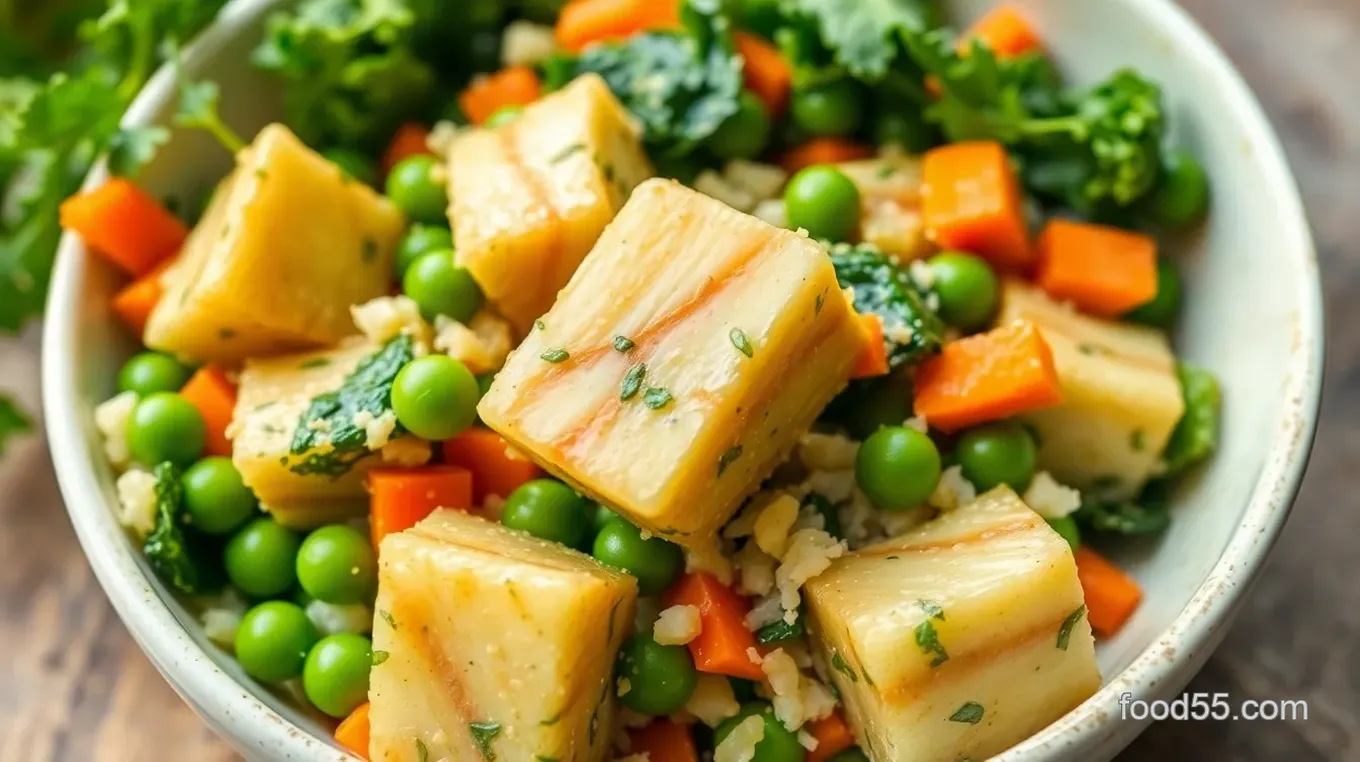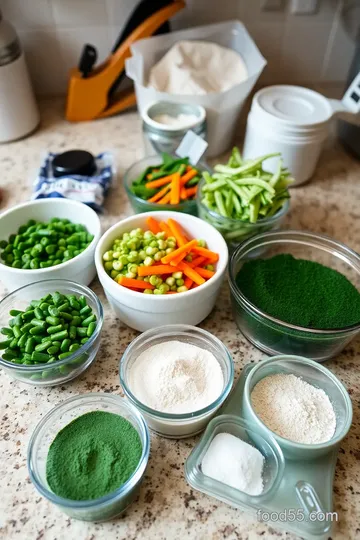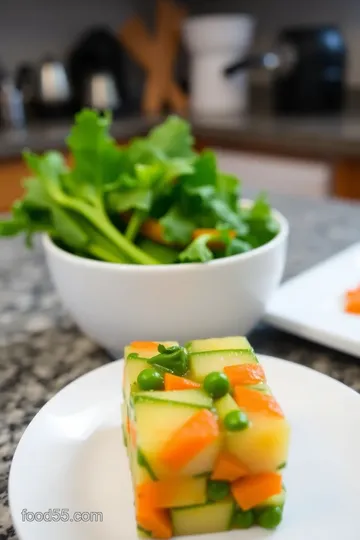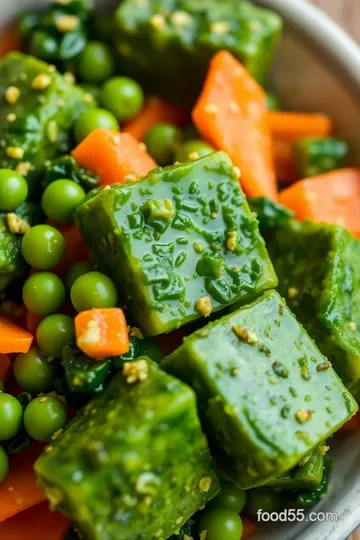Delicious Veggie-Packed Fish Food Cubes
How to blend veggies for tasty fish food cubes that your aquatic pets will love! Easy recipe with my favorite tips for a healthy fish diet. Let's get cooking!

- look into into Deliciousness: How to Blend Veggies for Tasty Fish Food Cubes
- A Splash of History: The Journey of Homemade Fish Food
- What’s in It for Your Fish? The Benefits Galore
- Get Ready to Swim into the Ingredients!
- Essential Ingredients Guide for Aquarium Fish Food
- Professional Cooking Method: Crafting Delicious Fish Food Cubes
- Pro Tips & Secrets for Homemade Fish Food Cubes
- Perfect Presentation for Fish Food Cubes
- Storage & Make-Ahead Tips
- Creative Variations
- Complete Nutrition Guide
- Expert FAQ Solutions
- Recipe Card
look into into Deliciousness: How to Blend Veggies for Tasty Fish Food Cubes
Oh my gosh, have you ever watched your fish swim around in circles, only to realize they’re waiting for their next meal? i swear, it’s like they have an internal clock! a couple of years ago, i was on a mission to provide my aquarium buddies with the best homemade treats.
That's when i stumbled upon the idea to blend veggies for tasty fish food cubes . honestly, the joy on their little faces made it all worth it.
Using fresh ingredients, i wanted to create something colorful and nutritious. after all, fish nutrition matters too! if you’re tired of store-bought options filled with who-knows-what, let’s explore how we can whip up some healthy fish treats together.
A Splash of History: The Journey of Homemade Fish Food
So, where did the idea come from? traditionally, fish food has been pretty basic—think flakes and pellets. but fish keepers like myself have started looking closer at pet fish care .
We want to know what our aquatic pals are munching on! as we discovered how important a nutrient-rich fish diet is, the trend for homemade fish food began catching on.
And now, diy fish food cubes are becoming a must-have for sustainable fish keeping.
Let’s break it down. this delicious veggie-packed fish food cubes recipe is not just a fun project; it's an easy one too! you’ll need about 1 hour total ( 15 minutes prep, 30 chilling, and 15 steaming), and it’s perfect for folks of all skill levels.
And the best part? you’ll yield around 20 cubes , enough to keep your finned friends happy for days.
What’s in It for Your Fish? The Benefits Galore
Now, you might be wondering, why bother making my own fish food? Here are a few reasons:
First off, fresh fish diet is ideal! you’ll be blending up colorful veggies like zucchini, carrots, and pea pods, making sure your fish get loads of vitamins and minerals.
Plus, this is a great way to cater to your fish's special dietary needs.
Let’s be real, fish love a little variety—who doesn’t? These cubes are not just nutritious and visually appealing; they’re also perfect for special occasions like birthdays—yes, you can celebrate your fish's “gotcha day” too!
Compared to traditional fish food, these homemade cubes let you control what goes in. you can toss in a pinch of spirulina for that extra health boost.
It’s honestly way better than any fish food alternatives you’d find at the store.
Get Ready to Swim into the Ingredients!
Alright, now that you’re pumped about this Delicious Veggie-Packed Fish Food Cubes recipe, let’s take a peek at the ingredients you’ll need.
Trust me, with just a few simple items, you’re on your way to whipping up some amazing vegetable fish food that your fish will be doing backflips over (if they could!).
Remember, just as with any recipe, don’t be afraid to customize . fish can be picky eaters, and your job is to find what works best.
If zucchini isn't in season, try using cucumbers or even some leafy greens.
I can’t wait to dive into the next part of this adventure with you. let’s get blending and serve up some of those nutritious fish snacks ! fish feeding has never been more fun or colorful.
Stay tuned, because it’s time to make those easy fish recipes a reality!

Essential Ingredients Guide for Aquarium Fish Food
Let’s dive into the world of homemade fish food , shall we? if you’re like me and love treating your fish to something special, you need the right fish food ingredients ready to whip up some amazing meals! it’s surprisingly simple, and your little aquatic friends will thank you for it.
Premium Core Components
To start, let’s chat about the basics. Here’s what you need to keep in mind for those vibrant meals:
Measurements: always have your ingredients ready in handy amounts. for us americans, stick to cups, teaspoons, and ounces. but if you like to get fancy, grab a scale— 1 cup of veggies is about 240ml , and if you’re cooking for larger fish, aim for around 150-200g of fresh veggies.
Quality Indicators: Check for freshness! Look for shiny, colorful veggies. They should be firm—not mushy. Avoid anything with brown spots. You want your fish food to be nutritious and appealing, right?
Storage guidelines: keep that produce fresh in the fridge. typically, veggies last 4-7 days in your crisper drawer. and if you make a big batch of diy fish food cubes, they can be frozen for a decent 3-6 months .
Just make sure to label those bags!
Freshness Tips: Always pick seasonal veggies. They pack more nutrients and flavor, which means healthier fish treats!
Signature Seasoning Blend
Alright, now let's spice things up. You can’t just toss in random herbs and hope for a tasty fish feast. Planning is key!
Essential spice combinations: a pinch of garlic powder can work wonders for flavor and is generally safe for most fish.
For that extra kick, think about adding a sprinkle of spirulina powder —it's packed with nutrients!
Herb Selections: Consider pairing basil or parsley with your veggie mix. They not only provide flavor but are loaded with vitamins.
Flavor Enhancers: A splash of fish oil is perfect for fatty acids. This little gem helps promote fish health and brings out nice flavor too.
Regional Variations: Ever thought about using sweet potatoes? They're a hit in Southern cooking and make a sweet twist on your classic veggie blend for fish!
Smart Substitutions
Life is unpredictable, isn't it? Sometimes, you gotta roll with what you got!
Common Alternatives: If you’re short on zucchini, switch it up with cucumber! Got some leftover pumpkin? That works too.
Dietary Modifications: For your veggie-phobic fish, use flake food or pellets to mix in. You can always customize fish food recipes according to your fish’s preferences.
Emergency Replacements: If you forgot to shop for peas, frozen ones work just fine! They retain nutrients and are quick to use.
Seasonal Options: In summer, grab fresh garden veggies. Winter? Look for frozen options—they're still healthy and accessible!
Kitchen Equipment Essentials
Before you get cooking, let’s make sure you have the right tools:
Must-Have Tools: A good steamer basket or pot for veggies and a blender for that smooth texture are absolute essentials. Trust me—you want it smooth!
Alternative Equipment: No steamer? No problem! Just boil your veggies until tender. Works like a charm!
Preparation Tips: When prepping, wash everything thoroughly. Anytime you deal with fresh food, remember cleanliness means happy fish!
Storage Solutions: Grab some ice cube trays or silicone molds. They’re perfect for your DIY fish food cubes . Once frozen, just pop them out, toss ‘em in a freezer bag, and you've got nutritious fish snacks ready to go!
So, now that you’re all set with essentials and tips, gather your ingredients and let’s roll into making those tasty fish food cubes .
Your finned friends are in for a treat that not only satisfies their hunger but also keeps them vibrant and healthy! ready? let’s get into the step-by-step instructions.
Professional Cooking Method: Crafting Delicious Fish Food Cubes
When it comes to preparing food, whether for yourself or your beloved fish, a little structure goes a long way.
Picture it: you’ve got a bustling kitchen, a timeline in your head, and a fridge full of vibrant veggies. let’s make something fabulous with those—particularly, blending veggies for tasty fish food cubes .
This isn’t just about throwing ingredients together but about embracing a methodical approach for scrumptious, homemade fish food.
Essential Preparation Steps
Mise en place —a fancy term that just means having everything in its place. before you even think about cooking, gather your ingredients and equipment .
For the fish food cubes, you’ll need zucchini, carrots, spinach, pea pods, fish oil, garlic powder, and maybe a little spirulina to boost the health benefits.
A steamer and a blender will do wonders!
Time management is crucial. title your time well: 15 minutes of prep and 15 minutes of cooking . sounds easy, right? but don’t forget 30 minutes chilling afterward, so plan on about an hour for the whole deal.
Also, organization helps. keep your work area tidy; trust me, it makes clean-up way easier. and, safety first , folks! if you're steaming veggies, be careful of that hot steam.
Use oven mitts or something to protect your hands.
Step-by-Step Process
Ready to roll? Here’s how to make these fishy delights:
- Prep the Veggies: Dice up that zucchini and carrot. Give those spinach leaves and pea pods a rinse.
- Steam: Toss the veggies into a steamer basket and bring water to a boil. Steam for 10- 15 minutes until they’re super tender.
- Blend It Up: Transfer those soft veggies to a blender. Add fish oil, garlic powder (if you’re feeling zesty), and a splash of water. Blend until smooth.
- Spirulina Magic: If you’re using spirulina, toss that in and blend just a bit more—so your fish get that extra oomph in nutrients!
- Fill the Molds: Spoon your mix into an ice cube tray. It’s gonna be a cute little fish food cube!
- Freeze: Pop those trays in the freezer until they’re solid, about 30- 60 minutes .
- Store: Once frozen, pack them in a freezer-safe bag. Make sure to label and date it!
Expert Techniques
To really nail this, keep an eye on your steaming. you want the veggies soft enough to blend. if things seem chunky after blending, add a smidge more water until you get that creamy texture.
Also, check your timing! timing is everything, so grab a timer! who wants gummy veggies, right?
You might run into a common hiccup: lumpy blends. Don’t fret! Just keep blending until everything is smooth. And remember, the fresher the veggies, the better the flavor!
Success Strategies
Avoid common pitfalls, like running out of ingredients mid-prep. double-check you have everything before diving in. quality assurance is key—look out for those bright colors and fresh smells.
That’s how you know you’re on the right path to creating nutritious fish snacks .
If you ever feel overwhelmed, remember DIY methods like these aren't strictly one-time deals. You can whip up a batch ahead of time and store them for quick feeding later.
Consider adding a twist, like incorporating some kale instead of spinach. Your fish will appreciate the variety, and you'll get the fun of mixing up your fish food recipes.
Wrap Up
And there you have it! easy to make, nutritious, and visually appealing, these diy fish food cubes will jazz up your fish’s diet while saving you cash on store-bought options .
Each little cube is full of everything your fish need for a vibrant, healthy life, plus it’s a simple way to keep their colorful fish food varied and exciting!
So, the next time you say, “i want to make some homemade fish food,” just remember these steps. you’re not just feeding them—you’re nurturing them with delicious, healthy fish treats .
Now, let’s transition to something else you might want to know about: additional information .

Pro Tips & Secrets for Homemade Fish Food Cubes
Oh my gosh, making your own fish food sounds like a project, right? but trust me, it's so worth it.
Here are a few pro tips and secrets that’ll make your life easier when you’re set to blend veggies for tasty fish food cubes .
First off, you want to prep your veggies properly. make sure they’re washed and chopped into small pieces. this helps them steam evenly and makes blending a breeze.
When steaming, keep an eye on the timer. you want those veggies tender but not mushy. nobody wants a smoothie of fish food, am i right?
Time-saving technique alert! if you're short on time, you can steam a batch of veggies ahead of time and freeze them.
That way, you can whip up a fresh batch of homemade fish food any time. just pull out some pre-steamed veggies and blend.
Easy peasy!
And don’t forget about flavor enhancement. A sprinkle of garlic powder can spice things up for your finned friends. It’s optional, but hey, fish have taste buds too!
Perfect Presentation for Fish Food Cubes
Now, let’s talk about presentation . yes, even fish food deserves love! when you fill your ice cube tray, consider mixing colors.
Toss in some vibrant beets or carrots for a colorful twist! when it comes to fish food, colorful options not only look good but are often packed with various nutrients that can benefit your aquatic pals.
Once frozen, pop these cubes into a clear container for storage. it’s all about that visual appeal, you know? a clean, organized freezer will make your homemade pet food game look extra sophisticated.
Storage & Make-Ahead Tips
So, how do we keep these fish food cubes fresh? store them in a freezer-safe bag and label it with the date.
Freshness is key! they’ll stay good for about three months , but let’s be real—you’ll probably run out well before that!
When you’re ready for feeding time, simply pop out a cube and let it thaw for a few minutes in your hand, or drop it straight into the tank frozen.
Trust me, your fish will love the challenge!
Creative Variations
Here’s where it gets fun! you can really get creative with this recipe. want to change it up? try using seasonal veggies like squash in the summer or even pumpkin in the fall.
You can also adjust the ingredients to cater to your fish’s specific needs. if you have herbivorous fish, blend vegetables for fish can be their main snack.
For dietary modifications, you can even use flaxseed oil instead of fish oil. This is a great option for those looking for a more plant-based approach.
Complete Nutrition Guide
It’s not just about making something look pretty; your fish need a nutritious diet too! Each cube packs a punch with vitamins and minerals. You can break down the nutrition as follows:
- Calories per cube: 15
- Protein: 0.5g
- Fat: 1g
- Carbohydrates: 2g
You want to make sure you’re meeting your fish's dietary needs, especially for species that thrive on a nutritious fish diet . Always customize according to their requirements!
Expert FAQ Solutions
Got questions? don’t worry—you're not alone! many pet owners face similar dilemmas. one common question is, “can i add other ingredients?” absolutely! just make sure they’re safe for fish first.
Another thing to consider is how to troubleshoot if the cubes are hard to blend. if they are, ensure the veggies are steamed well enough.
Feeling adventurous? Try out different fish food recipes and mix in other healthy treats. Just keep an eye on your fish's reaction to new flavors and textures.
Wrap-Up
So there you go! making homemade fish food doesn’t just benefit your fish—it's super rewarding for you too. you get to customize their meals, save a few bucks, and know exactly what’s going into their food.
Plus, it’s a breeze once you get the hang of it. it helps to create a sustainable fish keeping routine that’s good for you, your fish, and the planet.
Start blending those veggies today, and have fun experimenting with your very own fish food creations!

Delicious Veggie-Packed Fish Food Cubes Card

⚖️ Ingredients:
- 1 small zucchini, diced (about 150g)
- 1 carrot, diced (about 100g)
- 1 cup spinach leaves (fresh, about 30g)
- 1 cup pea pods (fresh or frozen, about 150g)
- 1 tablespoon fish oil (15ml)
- 1/2 teaspoon garlic powder (optional)
- 1 tablespoon water (15ml)
- Optional: A pinch of spirulina powder (for added nutrients)
🥄 Instructions:
- Step 1: Wash and dice zucchini and carrot. Rinse spinach leaves and pea pods.
- Step 2: In a pot, bring water to a boil, place vegetables in a steamer basket and steam for 10-15 minutes until tender.
- Step 3: Transfer steamed vegetables to a blender. Add fish oil, garlic powder (if using), and water. Blend until smooth.
- Step 4: Mix in spirulina powder until well incorporated (optional).
- Step 5: Spoon the mixture into an ice cube tray or silicone mold.
- Step 6: Place the molds in the freezer until completely firm (about 30-60 minutes).
- Step 7: Once solid, transfer cubes to a freezer-safe bag or container for storage.
Previous Recipe: Easiest Bake BBQ Chicken Puff Pastry Delightfully: 5 Tips for Perfection!
Next Recipe: How to Make Mixing Solomon's Tonic for a Healthy Boost: My Easy Recipe
